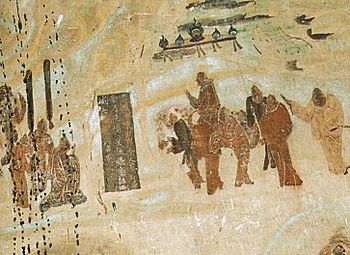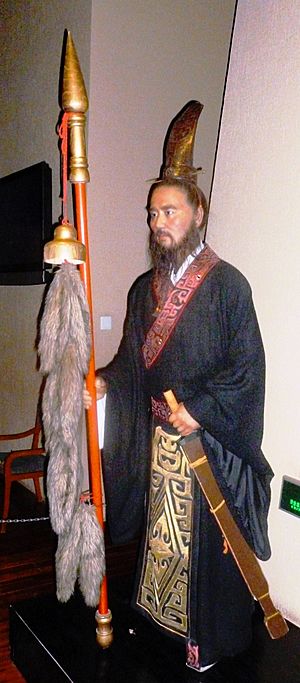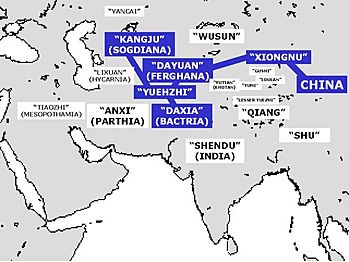Zhang Qian facts for kids
Quick facts for kids
Zhang Qian
張騫 |
|
|---|---|

Zhang Qian taking leave from emperor Han Wudi, for his journey to Central Asia from 138 to 126 BC, Mogao Caves mural, 618 – 712...
|
|
| Born | (unknown) |
| Died | c. 114 BC |
| Occupation | Explorer |
| Zhang Qian | |||||||||||||||||||||
|---|---|---|---|---|---|---|---|---|---|---|---|---|---|---|---|---|---|---|---|---|---|

"Zhang Qian" in Traditional (top) and Simplified (bottom) Chinese characters
|
|||||||||||||||||||||
| Traditional Chinese | 張騫 | ||||||||||||||||||||
| Simplified Chinese | 张骞 | ||||||||||||||||||||
|
|||||||||||||||||||||
Zhang Qian (Chinese: 張騫; died around 114 BC) was a brave Chinese official and explorer. He lived during the Han dynasty and was one of the first official diplomats to travel far outside China. He brought back amazing information about places like Central Asia, including parts of the old Macedonian Empire and the Parthian Empire.
His journeys were very important for China's future. They helped open up lands west of Xinjiang, including parts of Central Asia. These trips also helped create the famous Silk Road. This road was a network of trade routes that connected countries in the East and West, starting a new era of global connections.
Emperor Wu of Han sent Zhang Qian on these missions. The main goals were to start trade along the Silk Road and find allies for China. His travels opened up new trade routes, allowing different products and kingdoms to connect. Today, Zhang Qian is seen as a Chinese national hero. He is honored for his key role in connecting China with the rest of the world through trade and alliances.
Contents
Zhang Qian's Incredible Journeys

Zhang Qian was born in a place called Chengdu district, near Hanzhong in Shaanxi, China. He became an official serving Emperor Wu of Han around 140-134 BC. At that time, nomadic tribes called the Xiongnu controlled much of what is now Inner Mongolia. They also controlled the "Western Regions," which were areas near the Han Dynasty's land. The emperor wanted to trade with distant lands, but the Xiongnu made it hard to travel safely.
First Mission: Seeking Allies
In 138 BC, Emperor Wu sent Zhang Qian on his first big mission. He led a group of 99 people to the Western Regions. His goal was to find and make an alliance with the Yuezhi people against the Xiongnu. A guide named Ganfu, who was a captured Xiongnu, went with him.
To reach the Yuezhi, Zhang Qian had to pass through Xiongnu land. Sadly, the Xiongnu captured him and Ganfu. They held Zhang Qian as a slave for 13 years! During this time, he married a Xiongnu woman and had a son. He even gained the trust of the Xiongnu leader.
Escape and Discoveries
Eventually, Zhang Qian, Ganfu, and Zhang's family managed to escape. They traveled past Lop Nor and along the northern edge of the Tarim Basin. They went through small towns in oases in what is now Xinjiang. Finally, they reached Dayuan and then the land of the Yuezhi.
The Yuezhi were farmers. They had strong horses and grew new crops like alfalfa, which was good for animal food. However, the Yuezhi were too settled to want to fight the Xiongnu. Zhang Qian spent a year with the Yuezhi and in nearby Bactria. He learned a lot about their cultures, ways of life, and economies.
On his way back to China, he was captured by the Xiongnu again. They spared his life because they respected his strong sense of duty. Two years later, the Xiongnu leader died, and Zhang Qian escaped during the confusion. Out of the original group of over a hundred men, only Zhang Qian and Ganfu made it back to China.
Return and Recognition
Zhang Qian returned in 125 BC with amazing news for the Emperor. He reported that there were advanced civilizations to the West. China could benefit greatly from connecting with them. He told the Emperor about Dayuan, Daxia, and Anxi. These were all large states with unique products. Their people farmed and lived much like the Chinese. Zhang Qian said these states were not strong militarily but valued Chinese goods.
The Emperor was very pleased. Zhang Qian was honored with a high position as a palace counselor. Even though he couldn't form a military alliance, his efforts led to trade missions. These missions eventually opened trade between China and places like Persia.
Zhang Qian also noticed products from what is now northern India. He tried a second mission to find a trade route to India through Sichuan, but it was not successful. Later, from 119-115 BC, Emperor Wu sent him on a third mission to build ties with the Wusun people.
Zhang Qian's Important Reports
Zhang Qian's travel reports were written down by the historian Sima Qian in the 1st century BC. These reports are found in a famous Chinese history book called "Records of the Grand Historian" (Shiji). Zhang Qian directly visited the kingdom of Dayuan in Fergana, the lands of the Yuezhi in Transoxiana, the Bactrian country of Daxia, and Kangju. He also reported on other nearby countries he didn't visit, like Anxi (Parthia), Tiaozhi (Seleucid Empire in Mesopotamia), Shendu (India), and the Wusun.
Dayuan (Fergana)

After escaping the Xiongnu, Zhang Qian visited Dayuan, located in the Fergana region. He described the people of Dayuan as advanced city dwellers, similar to the Parthians and Bactrians. The name Dayuan might come from "Yona," referring to the Greek descendants who lived there.
Zhang Qian famously reported about the tall, powerful "blood-sweating" Ferghana horses from this region. These horses were so important that China later launched two wars to get them.
Zhang Qian wrote: "Dayuan lies south-west of the Xiongnu, about 5,000 kilometers west of China. The people farm the land, growing rice and wheat. They also make wine from grapes. They live in houses within fortified cities. There are about seventy or more cities of different sizes, with a population of several hundred thousand."
Yuezhi (Rouzhi)
With help from the king of Dayuan, Zhang Qian traveled southwest to the Yuezhi land. He hoped to get their help against the Xiongnu.
He reported: "The Great Yuezhi live about 1,000 or 1,500 kilometers west of Dayuan, north of the Gui (Oxus) river. They are bordered by Daxia (Bactria) to the south, Anxi to the west, and Kangju to the north. They are nomads, moving with their herds, and their customs are like the Xiongnu. They have about 100,000 or 200,000 archer warriors."
Zhang Qian also explained that the Yuezhi originally lived in the eastern part of the Tarim Basin. He was the first Chinese person to write about one-humped dromedary camels, which he saw in this region.
Daxia (Bactria)
Zhang Qian likely saw the last days of the Greco-Bactrian Kingdom. It was being taken over by the nomadic Yuezhi. Only small, weak chiefs remained. Their civilization was urban, much like Anxi and Dayuan, and they had many people.
He wrote: "Daxia is about 1,000 kilometers southwest of Dayuan, south of the Gui (Oxus) river. Its people farm the land and have cities and houses. Their customs are like Dayuan. It has no single great ruler, only many small chiefs ruling different cities. The people are not good at fighting but are clever at trade. After the Great Yuezhi moved west and conquered Daxia, the whole country came under their control. The population is large, over 1,000,000 people. The capital is Lanshi (Bactra), where all kinds of goods are bought and sold."
Cloth from Shu (Sichuan) in China was found there, showing early trade connections.
Shendu (India)
Zhang Qian also reported about India, located southeast of Bactria. The name Shendu comes from the Sanskrit word "Sindhu," which means the Indus River. Sindh was a rich part of India then, ruled by Indo-Greek Kingdoms. This explains why Bactria and India seemed culturally similar.
He said: "Southeast of Daxia is the kingdom of Shendu (India)... Shendu, they told me, lies several thousand li southeast of Daxia (Bactria). The people farm the land and live much like the people of Daxia. The region is said to be hot and damp. The people ride elephants when they go to battle. The kingdom is on a great river (Indus)."
Anxi (Parthia)
Zhang Qian described "Anxi" as an advanced city civilization, like Dayuan and Daxia. "Anxi" is a name for the Arsacid Empire, which ruled regions along the Silk Road.
He reported: "Anxi is several thousand li west of the Great Yuezhi region. The people farm the land, growing rice and wheat. They also make wine from grapes. They have walled cities like Dayuan. The region has hundreds of cities of various sizes. Their coins are made of silver and show the king's face. When a king dies, new coins are made with the new king's face. The people keep records by writing on horizontal strips of leather. To the west is Tiaozhi (Mesopotamia) and to the north are Yancai and Lixuan (Hyrcania)."
Tiaozhi (Mesopotamia)
Zhang Qian's reports on Mesopotamia and the Seleucid Empire, or Tiaozhi, are less detailed. He didn't visit the region himself but reported what others told him.
He wrote: "Tiaozhi (Mesopotamia) is several thousand li west of Anxi (Arsacid territory) and borders the 'Western Sea' (which could be the Persian Gulf or Mediterranean). It is hot and damp, and the people farm and plant rice... The people are very numerous and ruled by many small chiefs. The ruler of Anxi (the Arsacids) gives orders to these chiefs and sees them as their subjects."
Kangju (Northwest of Sogdiana)
Zhang Qian also visited the area of Sogdiana (Kangju), where Sogdian nomads lived.
He reported: "Kangju is about 1,000 kilometers north-west of Dayuan (Bactria). Its people are nomads and are similar to the Yuezhi in their customs. They have 80,000 or 90,000 skilled archer fighters. The country is small and borders Dayuan. It is under the control of the Yuezhi people in the South and the Xiongnu in the East."
Yancai (Vast Steppe)
Zhang Qian also mentioned Yancai: "Yancai lies about 832 km north-west of Kangju. The people are nomads, and their customs are generally similar to those of Kangju. The country has over 100,000 archer warriors, and borders a great shore-less lake, perhaps what is now known as the Northern Sea (Aral Sea)."
Zhang Qian's Last Years and Legacy
Zhang Qian returned from his last journey to the Wusun in 115 BC. After his return, he was given the high position of "grand messenger," making him one of the nine most important government ministers. He died about a year later, around 114 BC.
His tomb is located near Ch'eng-ku. During repairs in 1945, a clay mold was found with the inscription "Home of the Bowang (Marquis)," which was a title given to him.
Other Important Achievements
From his missions, Zhang Qian brought back many important things. The most important were alfalfa seeds, which were used to grow food for horses. He also brought back knowledge of strong horses with hard hooves. Most importantly, he shared information about the many new products, people, and technologies in the outside world.
He spent 25 years traveling on these dangerous and important missions. Even though he was once seen as disgraced for being captured by the Xiongnu, by the time he died, the emperor had given him great honors.
Zhang Qian's journeys led to many economic and cultural exchanges between the Han Dynasty and the Western Regions. Because silk became the main product traded from China, this great trade route later became known as the Silk Road.
See also
 In Spanish: Zhang Qian para niños
In Spanish: Zhang Qian para niños


